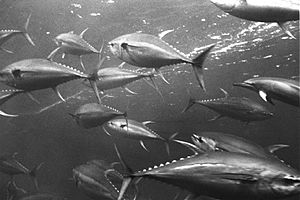Scombridae facts for kids
Quick facts for kids Scombridae |
|
|---|---|
 |
|
| Yellowfin tuna, Thunnus albacares | |
| Scientific classification |
|
| Kingdom: | Animalia |
| Phylum: | Chordata |
| Class: | Actinopterygii |
| Order: | Scombriformes |
| Suborder: | Scombroidei |
| Family: | Scombridae Rafinesque, 1815 |
| Subfamilies | |
|
Gasterochismatinae |
|
The mackerel, tuna, and bonito family, Scombridae, includes many of the most important and familiar food fishes. The family consists of 51 species in 15 genera and two subfamilies. All species are in the subfamily Scombrinae, except the butterfly kingfish, which is the sole member of subfamily Gasterochismatinae.
Scombrids have two dorsal fins and a series of finlets behind the rear dorsal fin and anal fin. The caudal fin is strongly divided and rigid, with a slender, ridged base. The first (spiny) dorsal fin and the pelvic fins are normally retracted into body grooves. Species lengths vary from the 20 cm (7.9 in) of the island mackerel to the 4.58 m (15.0 ft) recorded for the immense Atlantic bluefin tuna.
Scombrids are generally predators of the open ocean, and are found worldwide in tropical and temperate waters. They are capable of considerable speed, due to a highly streamlined body and retractable fins. Some members of the family, in particular the tunas, are notable for being partially endothermic (warm-blooded), a feature that also helps them to maintain high speed and activity. Other adaptations include a large amount of red muscle, allowing them to maintain activity over long periods. Scombrids like the yellowfin tuna can reach speeds of 22 km/hr (14 mph).
Classification
Jordan, Evermann and Clark (1930) divide these fishes into the four families: Cybiidae, Katsuwonidae, Scombridae, and Thunnidae, but taxonomists later classified them all into a single family, the Scombridae.
The World Wildlife Fund and the Zoological Society of London jointly issued their "Living Blue Planet Report" on 16 September 2015 which states that a dramatic fall of 74% occurred in worldwide stocks of scombridae fish between 1970 and 2010, and the global overall "population sizes of mammals, birds, reptiles, amphibians and fish fell by half on average in just 40 years."
The 51 extant species are in 15 genera and two subfamilies – with the subfamily Scombrinae further grouped into four tribes, as:
- Family Scombridae
- Subfamily Gasterochismatinae
- Genus Gasterochisma
- Subfamily Scombrinae
- Tribe Scombrini – mackerels
- Genus Rastrelliger
- Genus Scomber
- Tribe Scomberomorini – Spanish mackerels
- Genus Acanthocybium
- Genus Grammatorcynus
- Genus Orcynopsis
- Genus Scomberomorus
- Tribe Sardini – bonitos
- Genus Sarda
- Genus Cybiosarda
- Genus Gymnosarda
- Tribe Thunnini – tunas
- Genus Allothunnus
- Genus Auxis
- Genus Euthynnus
- Genus Katsuwonus
- Genus Thunnus
- Tribe Scombrini – mackerels
Timeline of genera

See also
 In Spanish: Escómbridos para niños
In Spanish: Escómbridos para niños

